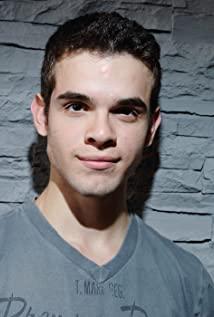2010's "Love, Holding Hands" only has 17 minutes, three characters: best friends Gi and Leo, transfer student Gabriel, two intertwined stories: Gi and Leo's friendship crisis, Leo and Gabriel's youthful sprouting. When the director said that he was going to make a real movie for this short, what he had to do was not make a follow-up, nor simply extend the time and add details, he told a bigger picture with sincerity. story.
In 2005, there was a gay short film "After Ashes". Like "Love, Holding Hands", the director also gave him a real movie "August Burning Ashes". "After the Ashes" tells the story of the protagonist, who has returned from his ex and has started a new life with his new boyfriend, and is caught in a dilemma. The same is true for the subsequent "August Burning Ashes", which also supported 100 minutes by these three characters and this not very complicated story. The director of "Ashes" added a follow-up to the basic line of the original story and modified the existing plot, but no matter how you look at it, people think that this is a 100-minute short film. Although the story has more infidelity and memories of the past than the original, as well as the inexplicable attitude of the current one, but in terms of the depth of the characters, the analysis of the story does not exceed the original film's great achievements.
A story that can be told clearly in 10 minutes, why drag it out to 100 minutes? Is it just for the director to add his own private goods plot, just for a few more passionate shots? Or, for a little more experimentation: the emotional chaos, the 3Ps in the second half, and the open ending.
"Oh yes, it's going to be like this, I knew that", complaining after watching "After Ashes" and then "August Burning". Everything about the movie has been fully explained in the short film, and the newly added plot is only superficial, and there is nothing new. The director who still used the short film method did not give people new ideas: the attempt of three people to support the audience, even if they were not careful, they flopped. Without Polanski's diamonds, don't count the number of people who can count on one hand to support the whole field.
In contrast, the turn from "Love, Holding Hands" to "Love, Simple" is very successful. At the beginning of the film, the 20-second overhead shot of Gi and Leo lying on the poolside basking in the sun and counting the laziness index has already conveyed such a message to the audience: listen to me. After that, I switched to smooth, well-composed dialogue shots without haste or slow, giving me a full-fledged, feature-length film feel. Seeing this, you can know that "Love, Simple" must bring something that "Love, Holding Hands", which is only 17 minutes long, does not contain.
The story begins at the end of the summer vacation. Although they are lazy and reluctant to part with the vacation, the boys and girls who enter the new semester will finally usher in a new beginning: the new transfer students Gabriel and Leo have a new environment - exchange student life - - anticipation, new challenges in Gi and Leo's friendship - for the first time a third person intervenes, etc. The beginning of the story foreshadows everything that comes after—new horse grabs and romance.
In the short film, the scenes in the classroom are not given too much to the teacher and other students, and the long film can be a little extravagant. The male classmate who coaxed Leo, the female teacher behind the desk, and Gi who quarreled for Leo and classmates. These once again remind the audience: hey, this is a very cinematic movie, and catching horses is not limited to the friendship and throbbing mentioned in the short film. The bullying Leo received from school, the quarrel with his parents during the rebellious period, and the always caring grandmother, the feature film elements have been collected.
In addition, Gabriel and Gi are also added in the film. Gabriel's hesitation after discovering his feelings for Leo, Gi's doubts about years of friendship, these scenes are not only expressed around Leo, They each have their own extensions. To say that the difference between a short film and a feature film, a large part lies in the division of the center. In Love, Holding Hands, the personalities of characters other than Leo are also built around Leo. In "Love, Simple", there are other characters who lead the plot development. Gabriel who took Leo to the movies, Gabriel who had an affair with Katrina, Gi who poured out his bitterness with Gabriel, and Gi who was so sad that he went to drink vodka. These also bring the audience into a true feature film.
Some screenwriters classify movie scripts as a stereotyped type: the main line A of the story climaxes in nearly three-quarters of the way, followed by a branch line B to calm emotions and trigger thinking. The most commonly used story of story B is a love story, and the development of story B will Promote the progress of the main plot from the side, and finally lead to the ending together. The B story in "Love, Holding Hands" is about Gi's troubles with the relationship between the two. In "Love, Simple", the ambiguous behavior of Gabriel and Katrina (D) is added on the basis of Gi's troubles about relationships (C). The first solution in the film is C, and then C promotes the solution of D (the good Gi finds Gabriel and asks him to visit the sick Leo), and the solution of D is equivalent to the perfect ending of the main line A. Complicated and sophisticated plot setting, director and screenwriter Daniel Ribeiro is indeed proficient in film. Each paragraph has a small climax, and each small climax is continuously summed up, leading the audience to the climax of the whole film.
In "Love, Simple", the clues run through, layer by layer, and passion is brewed in the foreshadowing, and the theme is complete, while the short film "Love, Holding Hands" is limited by time, when it expresses a narrative theme, then Use more ingenious techniques, such as replacing a plot with a shorter symbolic shot, mostly close-ups and panning.
Just like Lessing's understanding of the "moment" of plastic art: painting can only use a certain moment in the action in its juxtaposed structure in space, so it is necessary to choose the most germinative moment, so that the front and back can be used. All can be best understood from this moment. Lessing compares the "broad" poetry with painting. Because poetry can be described in language, using a variety of perspectives and literary techniques, it expresses a wider and richer space of intentions than painting. Therefore, the boundary between poetry and painting exists. Short films and feature films are also like Lessing's Poems and Paintings, with different limitations in time and space, and the selection of objects and methods are also different.
View more about The Way He Looks reviews








